When some friends invited us to the beach at West Wittering (near Chichester, England) last week, they asked me to bring some spelt bread, as they try to stay away from wheat.
Based on my previous experiments with spelt I came up with two very delicious.
Not even the fine sand on Wittering Beach (which gets just about everywhere) could do harm to the culinary experience (on the way home it was mentioned that we passed the food test ;-) )
== UPDATE ==
Several commentators inspired my to go fluffy with spelt - Today I made a small 100% Spelt Pugliese (light spelt flour),
the formula and photos are at the end of this post.
============
Here are some pictures:
The 100% Wholegrain Spelt (with a hint of honey and malt):
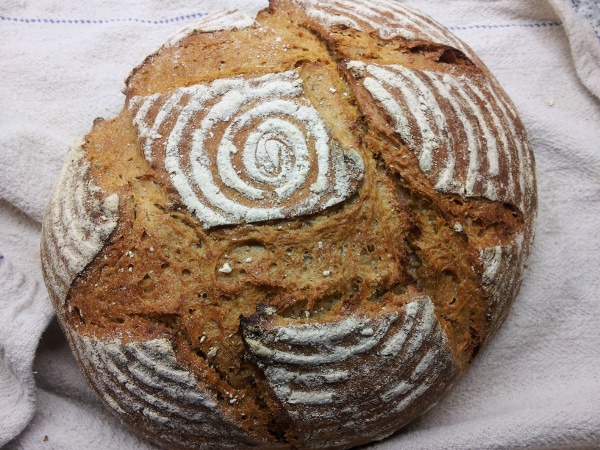
The same loaf, cut:
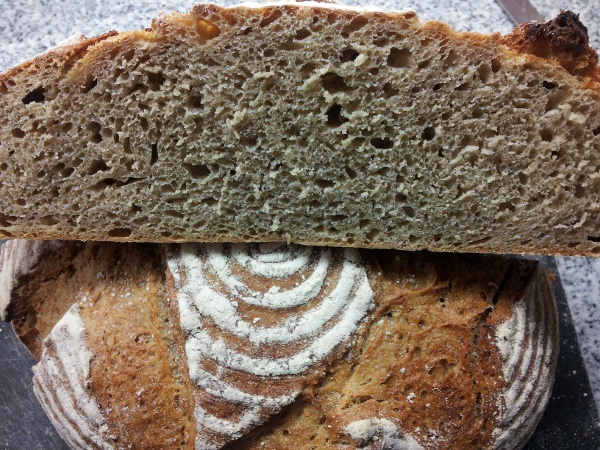
This loaf has a deep flavor. The rye malt and honey palance the spelt flavor very nicely without dominating it.
The other loaf was a 40% rye / 60% light spelt mixed bread:

Here the crumb:
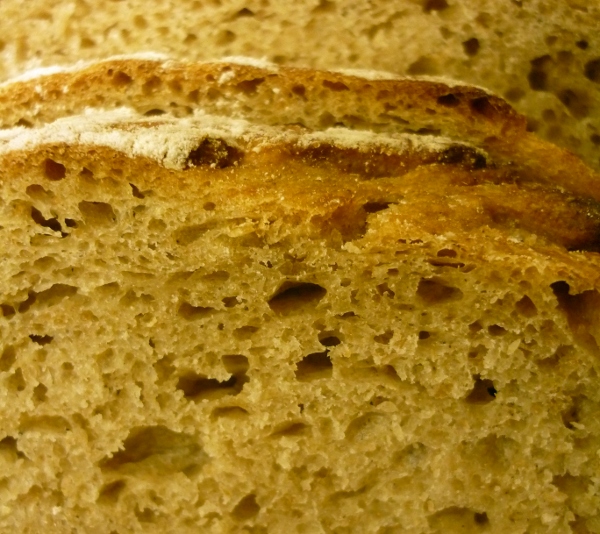
With a lot of rye present, this dough is quite a sticky mess. Try to handle it with a very light hand, taking care not to deflate it when shaping.
The formulas are on Google Docs:
== Update 30/05 6.19 GMT ==
Corrected the worksheet to read "Spelt Flour" instead of "Rye Flour"
This one is really 100% Wholegrain Spelt
======================
100% Wholegrain Spelt Sourdough
You can download / export the spreadsheets as Excel files (or other formats). The formulas are preserved, and you can adjust yield and other fields (marked yellow) to your liking.
Happy Baking,
Juergen
===========================================================
Here comes the Spelt Pugliese:
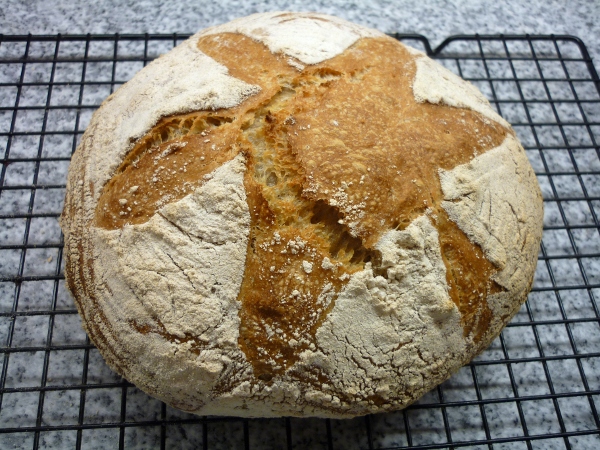
Here the crumb - nicely open and light:
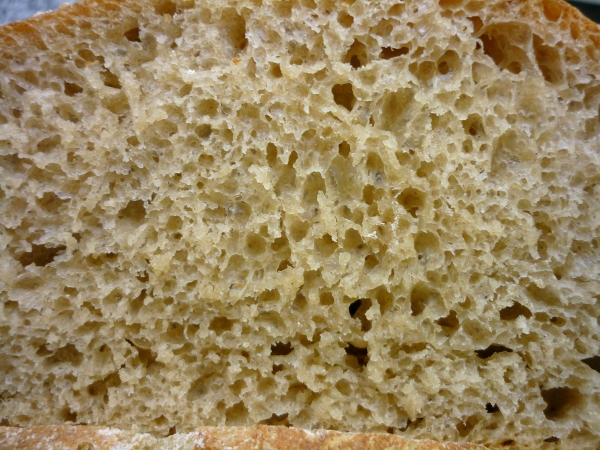
And here the formula:
I used light stoneground spelt flour from Sharpham Park
Bulk fermentation: 2 hours at 26dC, final rest 40 minutes
The formula is again on Google Docs:
https://docs.google.com/spreadsheet/ccc?key=0AkcYHhPxccKtdC1JOFpnWXJhYTZhbll4NWZKbFV3LVE
Happy Baking,
Juergen
- Juergen Krauss's Blog
- Log in or register to post comments
high % of spelt in these breads I know I would run the risk of brick making or loaves more likely having neutron star density. I love the taste of spelt in breads but you have to be a real fine baker to pull off your breads with 100% spelt. Now I have to go see the method you used to pull it off. I like that you can post your formula and then folks can change it to their needs and wishes.
Nice bake Juergen.
I thought it was 100% spelt but it hasa large amount for rye too. Still the crumb is nice and open especially on the 2nd loaf which is hard to do with so much whole grains. We would have to use YW too to get it that open.
Nice baking
Hi dabrownman, Thank you for your comments, they got my brain going and I realized I had the WRONG captions in the worksheet for the 100% Spelt. IT is really all wholegrain spelt flour.
This has now been corrected.
With regards to the structure: During bulk proof I do one or two folds, but very gently. I don't degas before shaping. It's all quite fragile.
And about 4 weeks ago my 6-year-old taught me a lesson about sourdough readiness: On that particular day he was licking clean the bowls that had contained my production sourdoughs ...
Thanks again,
Juergen
to clean the production bowls, without being told, means you have a future fine bread baker on your hands :-) I have to put higher % spelt in bread to see if we can get it to rise properly with a gentle touch. I wonder if it would work out using Chad Robertson's proofing and baking in a cold DO so you don't have to jostle it much?
I would like to see one of your 100% spelt bread formulas so will go back and check it out.
Thanks for posting your formulas.
Hi Juergen,
They are beautiful spelt breads. That crumb for a wholegrain spelt is fantastic. You must have been a very welcome visitor carrying those two loaves in :)
Cheers,
Phil
welcome. Thank you, Phil.
The other bread that was around (shop bought pita) didn't have a chance. Even the kids loved the wholegrain.
These will become regulars on my baking list.
Juergen
Juergen,
Everyone must have been so happy you shared these beautiful spelt breads with them!
:^) breadsong
breadsong.
We all arived on the beach very hungry and got quite irritable for a momment, but the good food we all contributed blew these clouds away immediately.
Juergen
Juergen,
I'm a big fan of spelt but have not used that high a percentage in my bread yet.
You have inspired me to give it a try.
Great looking bake.
Ian
Thank you,
Juergen
Hello Juergen,
I'm feeling encouraging pressure from different sources to start using Spelt flour. Sybille at Gilchesters' wants me to try baking with their Spelt too; heavy German enthusiasm, obviously.
Both your breads look so heasrty and inviting. But Spelt is such an expensive flour compared to any other because it is so low yield in the field, and it is so difficult to mill.
I wanted to ask you about your rye malt: where do you buy it, and in what form does it come [syrup, grain or flour]?
All good wishes
Andy
Hi Andy,
Thank you for your kind words.
Yes, Spelt is expensive. And it needs getting used to , at least I feel I just made a start at working with high % spelt breads.
Very rewarding though.
At Benjamin's school there are a few kids with wheat intolerance and some parents with a preoccupation against wheat. For them Spelt seems to be a nice complement to rye or gluten free breads.
I have made a baguette like bread with 100% light spelt in the past, with flying sponge and folding only. Worked very well and didn't need any sweeteners.
I am still quite lazy with my sourcing, almost everyting I use at the moment is from Shipton Mill, including the rye malt.
It comes as cut malted grains:
http://www.shipton-mill.com/flour-direct/rye-flours/shop-49/cut-malted-rye-grains-306?
I ground them down a bit with a pestle and mortar.
I tried making the wholegrain spelt without addition of malt and honey. It looked nice, but the taste wasn't that pleasing, somehow lacking depth. But it was nice toasted. Interesting experience.
Looking forward to reading about your spelt explorations,
Best Wishes,
Juergen
Juergen, Your breads look great and look really delicious. I had no idea a 100% spelt loaf could come out so nicely as I've heard it is a difficult grain to work with. I have only used spelt in small quantities as a boost to flavor, mainly because I have only found it in small quantities at high prices. Do you have a good source for it locally? -Varda
Hi Varda,
Thank you for your comment. But what can be difficult once you mastered the Altamura bread, as you did? Think along those lines. Spelt can be more sticky than Durum, but I found the handling to be quite similar. I have no doubt at all that you will make very nice spelt breads.
Spelt is expensive over here, too, but there is a huge difference in the price: from £1.45 per kg to £3.50 per kg.
Some brands are available in upmarket supermarkets (Doves Farm, Sharpham Park), others are on Amazon (Bacheldre) or the internet.
The wholegrain spelt I used is from Shipton Mill, the light spelt from Sharpham Park in Somerset (Might be considered local to Brighton in US terms).
The Sharpham Park flour is the most expensive one, but I like it. Truly stoneground, it has the appearance of a high extraction flour.
Best Wishes,
Juergen
PS. One of my favourite things to make with spelt is Egg Pasta:
Spelt Flour, Egg, a pinch of Salt, as you would do with wheat or durum. Very yummy.
I added pictures and formula for a very fluffy 100% Spelt Pugliese
Juergen
Juergen,
Beautiful loaves! A question for you. What is the definition of the word 'pugliese'? I have seen the word before but have not found a definition. A wild guess would be that it is a sd type of lean bread BUT a biga is used as the leavening agent which means no sd as the biga in your formula contains fresh yeast.
I will have to give the sd one a try. I have baked with spelt before but never with a leaven made from spelt flour too. Something fun to look forward to :-) Thanks for the inspiration to try something new!
Take Care,
Janet
Pugliesi looks terrific inside and out. I'm also wondering what a Pugliesi is. I thought it was a boule proofed seam side down in the basket and then baked seam side up, with no scoring, and it opened up naturally along the seam? Or is it just a bread that hails from Puglia. I still think we would make a brick with 100% spelt.
Nice baking all around Juergen!
Janet, DA,
Thanks for your appreciation.
To my knowledge "Pugliese" just means "From the Apulia Region". That's the area around Bari, including Altamura.
There are loads of recipes and procedures on the web. Some with, some without semolina.
Here a small comparison of wheat-based recipes which I have drawn up some time ago:
https://docs.google.com/spreadsheet/ccc?key=0AkcYHhPxccKtdEZIcTltNWRfOHdLSC0zSkV5aHR6V1E
And some recipes from Italian books:
http://www.theartisan.net/Pane_Pugliese_Frameset.htm
To me the specifics of most of the recipes - Biga, low yeast%, moderate hydration, long proof - result in a uniquely sweet, almost creamy crumb that could also be described as "cool".
My Spelt Pugliese has some of these features, but there is room for tweaking.
Janet, I found that this kind of bread works very well with raisin yeast water. Willl you post about your findings with spelt starter?
Brownman, You made some very pretty semolina breads. Think along those lines.
Cheers,
Juergen
for the explanation of the name. I wonder why all of these recipes use commercial yeast? Surely they had bread in the finest wheat growing region of Italy before 1887 and used SD or other natural starters to make fine bread. Are these formulas just eaiser, more convenient versions of previous verisons do you think?
I agree with you. Yeast water will be a nice addition to the crumb of these breads but they would be fine with SD alone. We will have to bake a SD, YW, spelt, rye, ww and semolina multi-grain pugliesi and see what it looks like. We bake David Snyder's Pugliesi more than any other bread (with some additional rye and WW in the mix per out taste).
Thanks for the links
In some of the sources (Carol Field, websites) one can read that this bread has been made with coarse flour, but I haven't come across such a recipe yet.
I can only speculate. I know a bit about Germany, and there - at the end of the 19th century -the countru was roughly divided into two - the wheat eating folks in the south and the rye eating folks in the north. Austria was very powerful at that time and I suppose Austrian bakers didn't only bring croissants to France - they brought Strudel to Italy etc etc. I suppose that people started to like white refined flour, and the bakers liked to speed up things a bit with yeast.
Making the Pugliese with Biga was a great experience for me - same ingredients as French dough, but a very different result. When I bake the white Pugliese the smell from the oven is almost buttery as if from an enriched bread.
The answer might lie in a German Wiki page:
http://de.wikipedia.org/wiki/Sauerteigf%C3%BChrung
There they classify sourdoughs, Type 0 being a yeasted preferment which is left for more than 8 hours and therefore has substantial lactic acid bacteria development:
I haven't made a sourdough (or biga naturale) Pugliese yet, but I will get at it this weekend (call it a Diamond Jubilese), and compare.
Another hint or idea comes from a document about the Detmolder single step process: you can add yeast to a sourdough starter to create a nutritional concurrency for the guys that make acetic acid, and you'll get a sweeter starter. I didn't try that yet, but I think the idea behind using yeast might be to bring out this special sweetness and butteriness in the Pugliese. I have read David's Pugliese post with interest, but I didn't get around to bake it yet.
Lots of interesting stuff here (and lots to eat ... I wish I could taste your jams with this bread)
Juergen
Hi,
I tried out a "sourdough Pugliese" with 2 starters with different hydrations and amounts of mature starter - my reasoning being to create some sort of biga to provide the sweetness (50% HL), and also to have a starter to create volume (70% HL).
The experimental formula for the bake is here (I also made a regular Pugliese for comparison):
https://docs.google.com/spreadsheet/ccc?key=0AkcYHhPxccKtdEJYRVJVNElyM1ZLVUhoVXRBd3pSdGc
Both breads are highly satisfying, but the taste is quite different. The sourdough version has a bit of the sweetness, but the overal flavor is a lot more complex than that of the yeasted specimen.
If you try this - watch the dough. The sourdough version needs a longer proof.
I'll keep experimenting ...
Juergen
Hi Juergen,
Thanks for the definition and the links about the Pugliese loaf. It is hard to tell with some bread names whether or not the name is derived from the ingredients used or the region where it is from. Now I know about the origins of Pugliese bread :-)
I baked your loaf today but I changed it a bit. I do my leaven builds during the day and then mix the final dough at night and the bulk ferment takes place in the refrigerator with shaping and baking taking place the following day....works better with my schedule.
This was a very nice dough to work with. I was a bit hesitant to do the leaven build as you posted it because I generally do a couple of shorter builds to maintain a mild flavor in my wholegrain leavens but I went ahead and followed your instruction. The leaven ripened within 7-8 hours and didn't smell as sour as I had expected. My daughter took a taste of the 'raw' dough when all the ingredients were mixed and she didn't taste any sour. She wasn't around this morning to taste it again - and I can't taste any of what I bake...so I rely on her...oh well. Loaves were a bit under-proofed as you will see in the photo - I was doing an experiment with a new flower pot Cloche lid and was a bit anxious to see how it would work and knew that under-proofing would show me more spring than if they over-proofed and I know spelt can over-proof very quickly.....anyway, here are the photos. Before and after.
No crumb shots as these are both headed out to neighbors but this formula will be baked again!
The flower pot experiment:
I scored the loaf on the left and not the one on the right but it 'sprang' just as much as the scored loaf!
So there you have it! Very nice loaves made with 100% spelt!
Thanks again for the inspiration, the post and all the historical notes :-)
Take Care,
Janet
Very nice 100% spelt cloched 2 ways. Love your pot too.
Hi Janet,
Your loaves look beautiful! I like the rustic look of the cracks. Maybe this is something to refine ...
I am glad your cloche worked out, and I am sure this will inspire lots of home bakers.
Best Wishes,
Juergen
Hi Juergen,
A follow up note. One of the people I gave 'your' loaf to is a very dear friend who is 85 years old - maybe even older....anyway, she said it was the BEST loaf of bread she has gotten from me. I was so happy to hear it and now know what to bake for her on special occasions and thought you might like to here it too.
Thanks again for the formula and the inspiration!
Take Care,
Janet
Thank you, Janet, for reporting this back to me.
Best Wishes,
Juergen
I have come to this thread a few days late, but if anyone is in doubt about using spelt flour I would urge them to try Bacheldre stoneground spelt flour, and as a first bake to do it as simply as possible with fast action yeast, a touch of sugar and some melted butter mixed into this flour with the requisite salt. Keep the dough fairly wet, prove and bake in a tin, when very easily you should have a delicious loaf, not dense but slightly crumbly and with a great flavour and smell.
Hi Aran, nice to hear from you.
Wen I had been asked to make spelt bread for the beach occasion I first thought of the refined loaf you brought to Oxford. But I couldn't remember the details, and my fingers were itching to do my tried and tested 40% rye with light spelt instead of wheat.
Best Wishes,
Juergen
Hi Juergen
My loaf at Oxford was spelt and rye with walnuts and honey, but your breads look superb and I am sure were right for the occasion. I will try the spelt pugliese in the next few days
Best wishes
Ruari